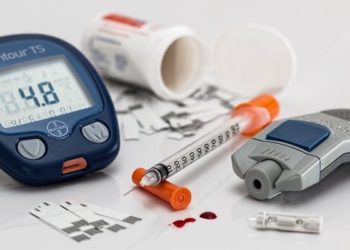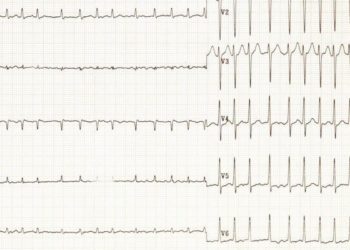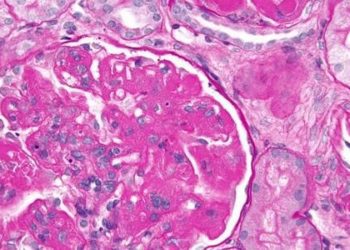2 Minute Medicine Rewind June 24, 2024
Duration of new-onset depressive symptoms during medical residency
1. In a cohort of incoming resident physicians in the United States, having a PHQ-9 score of ≥ 10, and thus experiencing depression, during their intern year had lasting effects including persistently higher mean PHQ-9 scores.
Evidence Rating Level: 1 (Excellent)
Mental health among physicians has been getting worse to the point that it has become a public health concern in the United States. It is commonly thought that residency is a particularly challenging time for physicians. Investigating these beliefs, a prospective cohort study, the Intern Health Study (IHS) was initiated to assess incoming first-year residents’ mental health. The primary outcome assessed was the mean PHQ-9 score and the proportion of residents with an elevated score (≥10; categorical or binary) at the follow-up. Included in the cohort were 858 resident physicians, with a mean (SD) age of 27.4 (9.0) years, who had a PHQ-9 score below 10 at the start of residency. To evaluate if there was persistent depression, the PHQ-9 score was compared at each follow-up year, between individuals who originally screened positive for depression and those who did not, during their intern year. Of the individuals who screened positive for depression, 21.9% of them (95% CI, 15.6%-29.8%) also screened positive a year after finishing their intern year. On the other hand, of the individuals who screened negative for depression, only 6.6% (95% CI, 4.2%-10.3%) of them screened positive for depression one year later. The same groups were investigated again 5 years after their intern year, and 8.8% (95% CI, 5.8%-13.1%) who originally screened positive for depression still had depression, while 2.4% (95% CI, 1.4%-4.5%) who originally screened negative for depression now had elevated PHQ-9 levels (P<.001). Physicians who had a PHQ-9 score ≥10 during their internship also had elevated mean PHQ-9 scores at 5 years (4.7 [95% CI, 4.4-5.0] vs 2.8 [95% CI, 2.5-3.0]; P<.001) and 10 years (5.1 [95% CI, 4.5-5.7 vs 3.5 [95% CI, 3.0-4.0]; P<.001) compared to physicians who did not have an elevated PHQ-9 score. There was an association between physicians who had an elevated PHQ-9 score (≥10) and a higher likelihood of reaching the threshold during each follow-up year. Overall, many physicians experienced an increase in depressive symptoms during their internship, which may persist through some of their careers.
Cannabis, tobacco use, and COVID-19 outcomes
1. In a cohort of individuals diagnosed with COVID-19, the modifiable risk factors, smoking and cannabis use, were associated with an increase in hospitalization and intensive care unit (ICU) admission, with smoking also associated with increased mortality.
Evidence Rating Level: 2 (Good)
Even in the post-pandemic era, COVID-19 is still a risk to public health and continues to cause fatalities. Past studies have explored the association between nonmodifiable risk factors and COVID-19 outcomes; however, few have focused on some modifiable risk factors such as substance use, specifically cannabis and tobacco. To understand the relationship between COVID-19 outcomes and cannabis and tobacco use, a retrospective cohort study was conducted using electronic health record (EHR) data for individuals throughout the Midwest United States. Individuals could participate in the study if they were identified as having COVID-19 (meeting 1 of 3 criteria) between February 1, 2020, and January 31, 2022. The main outcomes were hospitalization, intensive care unit (ICU) admission, and all-cause mortality, including posthospital mortality. Univariate and multivariate logistic regression models were used to assess the association between substance use and COVID-19 outcomes. The models adjusted for confounding variables such as race, sex, ethnicity, and comorbidities. The study included 72 501 cases of COVID-19, with patients ranging from 12 years to older than 90 years of age, leading to a mean (SD) age of 48.9 (19.3) years. Of the cases, 51 006 (70.4%) involved hospitalization, 4725 (6.5%) needed an ICU visit, and 2717 (3.7%) cases resulted in death. A total of 49 881 (68.6%) patients identified at least 1 comorbidity possibly affecting the outcomes of their COVID-19 sickness. Of the most common comorbidities, diabetes was present in 13 457 (18.6%) patients, obesity in 35 029 (48.4%) patients, and cardiovascular disease in 12 900 (17.8%) patients. Current smoking was identified in 9710 (13.4%) patients, while former smoking was identified in 17645 (24.4%) patients, and current cannabis use in 7060 (9.7%) patients. After adjusting for confounding variables, current smoking (odds ratio [OR]. 1.72; 95% CI, 1.62-1.82; P<.001) and former smoking (OR, 1.27; 95% CI, 1.21-1.33; P<.001) were associated with a higher risk of hospitalization due to COVID-19 compared to never smoking. Similarly, when compared to never smoking, current smoking (OR, 1.22; 95% CI, 1.10-1.34; P<.001) and previously smoking (OR, 1.25; 95% CI, 1.16-1.33; P<.001) were both associated with a higher risk of ICU admission due to COVID-19. The risk of mortality was also increased in participants who currently smoke (OR, 1.37; 95% CI, 1.20-1.57; P<.001) and who previously smoked (OR, 1.42; 95% CI, 1.30-1.55; P<.001). For cannabis use, there was an increased risk of hospitalization (OR, 1.80; 95% CI, 1.68-1.93; P<.001), and ICU admission (OR, 1.27; 95% CI, 1.14-1.41; P<.001), but there was no association with an increased risk of mortality when compared to those who did not use cannabis. In summary, previous and current cigarette smoking was associated with an elevated risk of hospitalization, ICU admission, and all-cause mortality in patients with COVID-19. While cannabis use was associated with an increase in hospitalization and ICU admission in patients with COVID-19.
1. Neighbourhoods experiencing worse sociodemographic environments in the southeastern United States were associated with higher mortality, possibly resulting from circulating metabolites.
Evidence Rating Level: 1 (Excellent)
Social determinants of health such as socioeconomic status (SES), race, ethnicity, and geographic region all play a role in people’s health, specifically disproportionately affecting Black adults compared to non-Hispanic White adults. Neighbourhoods have been linked to worse health outcomes, possibly due to an interplay of social, physical, and biological factors. Although previous studies have investigated the association between geographic location and disease, there has not been in-depth research focusing on health outcomes in low-SES Black adults. To address this gap in the literature, a prospective cohort study was conducted in which researchers recruited individuals from community health centers and obtained information through questionnaires regarding their demographics, lifestyles, and past medical histories. Three metrics, neighbourhood deprivation (NDI), residential segregation (RSI), and social vulnerability (SVI) were established. A total of 79631 participants with a median age of 51 years (interquartile range [IQR]: 45-58) were followed for a median of 15 years. Among these participants, 7214 died from CVD and 5394 from cancer. The results found that higher NDI, RSI, or SVI was associated with increased all-cause mortality. Standard risk factors make up 40% of NDI/RSI/SVI variations and 70% of their association with mortality. Plasma metabolite profiling included 1110 metabolites in 1688 participants. There were no metabolites associated with SVI, however, 134 metabolites were associated with NDI while 27 were associated with RSI (5% FDR). The NDI and RSI metabolites imparted 61.7% and 21.2% of their connection to all-cause mortality, compared to 38.4% and 25.8% for standard risk factors, totalling 87% for NDI and 42.6% for RSI mediation proportions. Overall, a neighbourhood with a lower SES was associated with a higher risk of all-cause mortality, CVD, and cancer-specific mortality. Additionally, circulating metabolites may explain biological pathways leading to the health effects of a neighbourhood.
1. Nulliparous women undergoing vacuum-assisted delivery randomized to receive lateral episiotomy were observed to have a lower rate of anal sphinter injury compared to control.
Evidence Rating Level: 1 (Excellent)
One severe complication of vaginal birth is obstetric anal sphincter injury which can lead to anal incontinence and subsequently a decreased quality of life. Primiparity and instrumental birth (such as using a vacuum) are risk factors that may lead to an obstetric sphincter injury. The effects of an episiotomy on an obstetric sphincter injury are not clear, and it was previously mentioned that more research must be conducted. In this multicentre, open label, randomised controlled trial, researchers attempted to understand the impact of a routine lateral episiotomy on obstetric anal sphincter injury risk in nulliparous women. Obstetric anal sphincter injury was defined as a perineal injury to the third or fourth degree involving the anal sphincter muscles, whether external, internal, or both. The study included nulliparous women with a singleton, live, fetus, requiring vacuum extraction during birth, who were randomly assigned in a 1:1 ratio of either receiving a lateral episiotomy or not receiving one. The obstetrician at the time of birth decided if a vacuum extraction was the right choice for the patient, and randomization took place afterwards. The episiotomy began 1-3 cm from the posterior fourchette at an angle between 45-80° for a length of 3-5 cm. Of the 717 participants, 354 (49%) received a lateral episiotomy while 363 (51%) did not receive one. Only 702 individuals were in the intention-to-treat population since 14 had given birth spontaneously before vacuum insertion (5 in the no episiotomy group and 9 in the episiotomy group), and one woman withdrew her consent. An obstetric anal sphincter injury occurred in 21 (6%) women in the episiotomy group and 47 (13%) women in the no episiotomy group (P=0.002), with an adjusted risk ratio of 0.47 (96% CI 0.23 to 0.97) and risk difference of -1.0% (96% CI, -11.7% to -2.5%). In the intervention group, the number needed to treat with an episiotomy was 14.3 (96% CI, 8.6 to 40.0) to avoid obstetric anal sphincter injury. First-degree injuries were less prevalent in the intervention group while second-degree injuries were more prevalent. In conclusion, lateral episiotomy was associated with a decreased risk of obstetric anal sphincter injury in nulliparous women.
1. In a population-based cohort study, a high magnitude of variation of serum uric acid (SUA) in patients with hyperuricemia was associated with negative changes in white matter and impaired microstructural integrity.
Evidence Rating Level: 2 (Good)
Brain health optimization leads to better physical and mental health along with improved overall well-being. Uric acid, the end product of purine metabolism plays an important role in the body as an antioxidant in plasma. There is mixed evidence for the concept of serum uric acid (SUA) as a protective factor for cognitive decline and dysfunction as some studies have suggested a neuroprotective effect while others suggest a negative association with brain health, such as decreased white matter (WM) volume, higher burden of WM hyperintensity (WMH) and presence of cerebral microbleeds (CMBs). This cohort study originates from the Kailuan Study (KLS) which aimed to assess risk factors for mortality, cardiovascular diseases, and metabolic syndrome. The participants were tasked with fasting overnight and then providing blood samples to be infused into a vacuum tube containing ethylenediamine tetraacetic acid (EDTA). After assessing for eligibility, 1111 participants between the ages of 25 to 83 years were enrolled. Amongst these individuals, the mean age was 55.2 ± 11.5 years, with 44.6% (496 of 1111) of the participants being female. The groups with increased and decreased SUA had smaller WM volume (beta = -0.25, 95% confidence interval [CI], -0.39 to -0.11, p value < 0.001; beta = -0.15, 95% CI -0.29 to -0.02, p value = 0.024). Lower fractional anisotropy (beta = − 0.24, 95% CI − 0.38 to − 0.10, p value < 0.001), higher mean diffusivity (beta = 0.16, 95% CI 0.04 to 0.28, p value = 0.010), and higher radial diffusivity value (beta = 0.19, 95% CI 0.06 to 0.31, p value = 0.003) were achieved through gradually higher SUA levels in participants. Before and after adjusting for WMH volume, the increase in SUA levels was associated with lower MoCa scores (beta = -0.18, 95% CI -0.32 to -0.04, p value = 0.010). When mediation was conducted for SUA and Moca scores, decreased WM and cerebral parenchyma volumes, as well as lower FA, and higher MD and RD values, mediated the increase SUA’s effect on lower MoCA values. Overall, an individual’s brain health is negatively affected by SUA magnitude variation, especially those with hyperuricemia.
Image: PD
©2024 2 Minute Medicine, Inc. All rights reserved. No works may be reproduced without expressed written consent from 2 Minute Medicine, Inc. Inquire about licensing here. No article should be construed as medical advice and is not intended as such by the authors or by 2 Minute Medicine, Inc.







